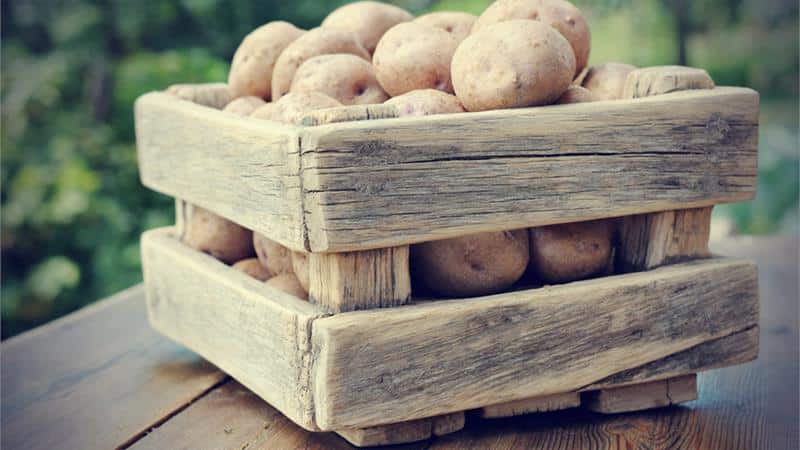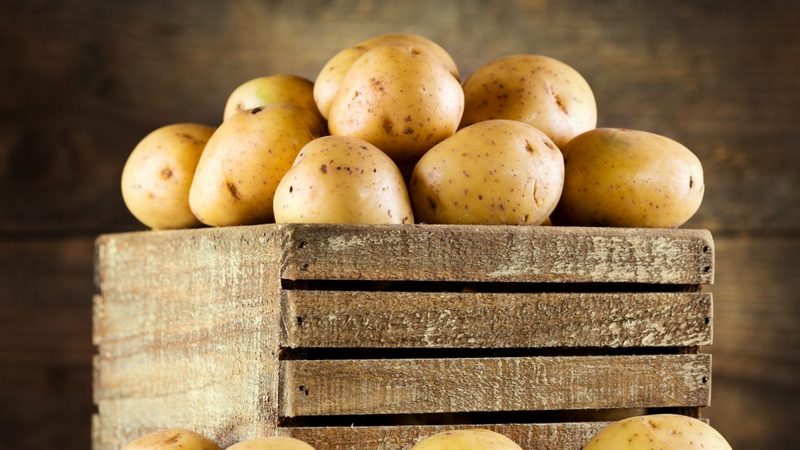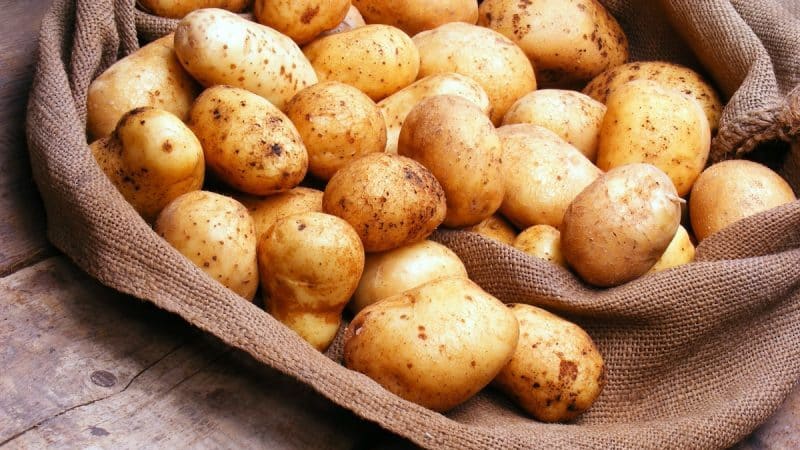Rules for storing potatoes: can they be washed before storing?
It’s nice to dig up even, large potatoes in the fall. But it’s not enough to grow an enviable harvest. It is also important to properly prepare it for storage in order to preserve it until spring without loss. One of the most common questions gardeners ask is whether they need to wash potatoes before planting them. storage. Some fear that this could ruin the entire harvest.
In this article we will figure out whether it is necessary to wash potatoes before storing them for the winter and which tubers are best stored - washed or unwashed.
Is it permissible to store washed potatoes?

Is it possible to leave washed potatoes for the winter? Yes, you can, especially if it was dug up in rainy weather. However, it is important to thoroughly dry the tubers before storing.
The storage conditions are of decisive importance for the safety of the crop: optimal indicators are temperature from +2 to +4°C and humidity – 80-90%.
Advantages and disadvantages of washing potatoes
Is it possible to wash potatoes before storing them? We figured it out. Now we list the main advantages and disadvantages of storing washed tubers.
Advantages:
- Washing off the dirt allows you to immediately assess the condition of the potatoes. All defects (scratches, cuts, areas of rot, etc.) are clearly visible on the washed peel. Just a few rotten potatoes that fall into the cellar will destroy all healthy specimens.
- It is more pleasant to deal with washed potatoes when cooking; they do not pollute the kitchen, balcony or loggia. Clean vegetables have an attractive presentation and surplus harvest will be easy to sell.
- Cleaning and processing the cellar after storing washed potatoes takes much less time. There is no need to remove the remaining soil.
This method also has disadvantages:
- If washed carelessly, the peel can be easily damaged. During further storage, infection penetrates into the tubers through scratches.
- It is difficult to properly dry washed tubers after washing, especially if there are a large number of them.
- Washing potatoes will require a lot of water, time and effort, as will drying them.
Shelf life of washed and unwashed potatoes
The shelf life of washed and unwashed tubers does not differ, provided that all potatoes have been thoroughly dried.
It is also important to carefully inspect the tubers before sending them to cellar. Only absolutely healthy specimens without damage, signs of disease or areas of rot are stored for winter storage.
Washing technology before storing
Considering the serious labor costs of washing and drying vegetables, as well as the cost of water, it makes sense to wash the entire crop only if the tubers are literally covered with wet soil. This happens if cleaning was carried out in wet weather.
Otherwise, it is enough to dry the potatoes and remove excess soil by hand when sorting and putting them in boxes.
Here's how to wash potatoes before storing:
- For washing, choose a large container, for example, an old bathtub. If you use a basin, you can make holes in its bottom - this will simplify the process.
- Pour cold water into a container and add potatoes in small portions. Gently mix with your hands for a while without damaging the peel. We change the water after each batch.
- Place clean potatoes in one layer on a prepared surface: wooden flooring or metal sheets.It is good to use unnecessary cardboard or fabric, changing and drying it from time to time. This substrate will quickly absorb excess moisture.
- To dry, choose a ventilated place in the shade or partial shade. Outdoors, the tubers dry in 4-8 hours. Turn them over periodically to dry evenly.
We put the vegetables in boxes or bags and send them to a cool place.
Advice. During washing, it is convenient to immediately sort the tubers into large, medium and planting ones. Also immediately discard sick and injured specimens.
Now the clean and thoroughly dried potatoes are ready for further processing before storage.
Preparation for storage
Before sending the crop to storage, it is carefully inspected and sorted.
Tubers intended for planting for the next season are stored separately. The remaining potatoes are sorted by size. Medium tubers last the longest, large ones - a little less. Specimens damaged during digging are not sent to the cellar at all. They are processed first.
Potatoes prepared for storing for the winter are exclusively whole, dry and healthy tubers. IN cellar Vegetables with signs of disease, damaged or scratched should not be included.
Need to know. Just a few diseased potatoes that fall into the general mass can ruin the entire harvest in a short time.
Sorted and dried vegetables are placed in small boxes or bags and left for several days in a cool place. The harvest is then transferred to the cellar or basement.
How to store washed potatoes: optimal conditions
Store washed potatoes for the winter in the same conditions as unwashed ones. The maximum storage time for the crop is observed when the temperature is from +2 to +4°C and the air humidity is 80-90%.
As the temperature rises, the potatoes begin to sprout and become flabby. Harmful substances accumulate in the vegetable, and it can no longer be eaten.
When exposed to negative temperatures or stored at 0°C, the starch in the tubers is converted to sugar, and the vegetable acquires a sweetish taste. However, short-term exposure to low negative temperatures does not lead to such consequences.

In the cellar or basement
A cellar or basement is suitable for storing potatoes. Before planting vegetables, the room is cleared of remnants of last year’s harvest, dried, ventilated, and disinfected. For disinfection, use a solution of lime, copper sulfate or a sulfur bomb.
Wooden boxes and boxes for storing vegetables, as well as flooring and shelving, are treated with a solution of potassium permanganate and thoroughly dried in the sun.
Attention! The cellar or basement must have good thermal insulation to protect food from frost and elevated temperatures.
On the balcony or loggia
In urban conditions, potatoes are stored on balconies and loggias. It is convenient for these purposes to use wooden boxes insulated with materials with waterproofing properties.
Make a box like this you can do it yourself from wooden boards or thick plywood. The best option is two boxes of different sizes, inserted one into the other. The void between them is filled with foam plastic, dry sawdust or other suitable material.
If you have neither the time nor the desire to build a box yourself, purchase a ready-made thermal container for the balcony. There are boxes and bags on sale with thermostats in which vegetables can be successfully stored at -40°C.
Common mistakes when storing potatoes

We list the most common mistakes that lead to spoilage of vegetables stored for storage:
- Wrong choice of variety for storage in the cellar. Only late and mid-season ones are planted for winter. They will last until spring without loss. Early ripening potatoes will last until November at best, even under ideal conditions.
- Storing undried potatoes. If you put wet vegetables in the cellar, this will inevitably lead to the rapid appearance of rot and damage to the crop.
- Laying tubers of poor quality. Only healthy and undamaged potatoes will be stored for a long time. When sorting, specimens with the slightest signs of rot, scratches, or cuts are mercilessly removed.
- Storing tubers in large piles. It is better to arrange vegetables in small boxes, boxes or bags. This makes it more convenient to use them and periodically go through them.
- Storage in the same container with other vegetables. You can only keep beets in one box or bag of potatoes. It is laid out on top to absorb excess moisture.
- Temperature violation. Air temperatures above +4°C or below +2°C have a bad effect on keeping quality. In the first case, the vegetables become flabby and sprout; in the second, they freeze slightly.
- Neglecting periodic inspections of vegetables in storage. By inspecting your supplies from time to time, it is easy to notice spoiled potatoes in time and remove them from the general pile.
By avoiding these mistakes, you will ensure the safety of vegetables until spring.
Conclusion
How best to store potatoes—washed or not—everyone decides for himself. When choosing a storage method, they are guided by the volume of the crop, the availability of sufficient water for washing and area for drying.Washing does not affect the shelf life provided that it is properly dried.